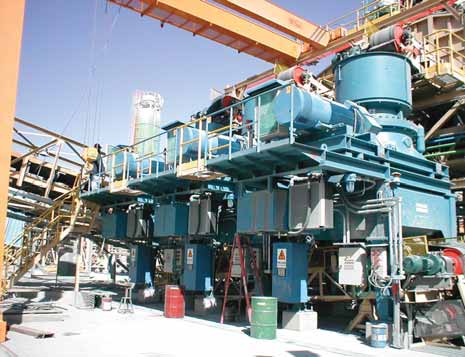
Minera Alumbrera has three cassette-configured Sandvik Hydrocone H-6800 machines in its
dedicated pebble treatment circuit.
Sandvik’s Cassette Concept Setup Can Solve Crusher
Downtime Dilemma
Christian Ottergren, VP-Crushing & Screening, explains this novel but
effective concept
to E&MJ’s Kyran Casteel

When a large crusher requires replacement of wear parts, a maintenance period of between one and three shifts is generally needed to complete the work. Production from that unit ceases completely and downtime continues until the crusher is readied for operation. Typically, plant designers have opted to minimize total crushing plant maintenance time by installing fewer but higher-capacity machines. The downside of this, however, is a large loss of production during maintenance periods and, Sandvik points out, mines often have downstream processes that do not take kindly to continuity breaks.
Building the crusher in cassette form for rapid replacement does not really impose limits on crusher size. Conceptual design studies have been done for 800-hp crushers. But, says Sandvik, it must be possible to handle the weights of the cassette units with the lifting capacity available. At the same time the concept makes the option of using a larger number of medium-sized crushers more attractive. Smaller crushers are easier to transport on site and do not need a concrete base. Utilizing the replacement cassette will minimize production downtime, and maintenance work on the withdrawn crusher will normally take less time than with a bigger crusher.
Sandvik provided the following comparison. A traditional plant has two large 400-750 kW (550-1,000 hp) crushers on concrete foundations, maintained on site. Four smaller 200-300 kW (270- 400 hp) cassette type crushers have been shown to provide the same production capacity as the two larger machines. Investment and operating costs are often, in fact, less for the smaller crushers and the cassette system gives the additional advantages of reducing production by only 25% while the exchange takes place, needing about one hour’s production interruption during the crusher switch, and eliminating the risk of additional downtime as a result of spares being unavailable or unforeseen additional work being required. The cassette can also be designed so that a Sandvik Hydrocone unit can be placed on the foundations for the 7-ft crushers widely used in the mining industry, providing a simple means of upgrading an existing plant with new high-performance crushers.
The cassette system also allows the maintenance staff to work on the worn crusher in the more favorable environment of the mine’s workshop rather than at the crushing plant. If part of the plant is kept operating, the service work is moved from the dusty and noisy workplace to a comfortable shop with far better safety. The time available before the next cassette crusher arrives, generally 40 hours or more, also allows the staff to work under less stress and undertake a comprehensive inspection of the crusher and any work found to be necessary.
Sandvik delivers crusher cassettes complete with all associated equipment, such as main motor, lube tank, etc. No hydraulic and minimal mechanical installation is needed; the crusher only needs plug-in connection to the power supply, control and automatic setting regulation system. Where a number of similarly equipped crushing operations are in close proximity it could be advantageous to use the cassette system as a shared facility.
In 2002, the Minera Alumbrera copper- gold operation in Argentina, which is sufficiently cost-conscious to rate as one of the world’s lowest cost copper producers, decided to install cassette crushers. To maintain metal output from decreasing ore grades the mine commissioned a 30% concentrator expansion, adding one new SAG mill and one new ball mill. To cope with the pebble product produced by the mill operation as a whole, a pebble treatment circuit comprising three Sandvik H-6800 EF hydrocone crushers in cassette form was installed. These crushers work in closed circuit, reducing pebbles to -12 mm. In Chile, the El Tesoro mine has seven Sandvik cassette crushing units for its heap leach operation. However, neither mine takes the cassettes to the workshop for maintenance, simply because each has crusher over-capacity so one crusher can be serviced on the spot without any loss of production.